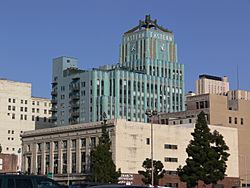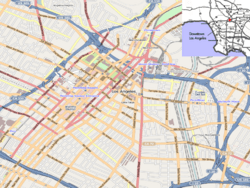Historic Core, Los Angeles facts for kids
Quick facts for kids
Historic Core
|
|
|---|---|

|
|
| Country | |
| State | |
| County | Los Angeles County |
| City | |
| Named | 1990s |
| Zip code |
90013
|
| Streets | 3rd Street, 4th Street, Broadway, Hill Street, Main Street, Olympic Boulevard, Spring Street |
The Historic Core is a cool neighborhood in Downtown Los Angeles. It's famous for having lots of old movie theaters, big department stores, and tall office buildings. Most of these were built a long time ago, between 1907 and 1931.
Inside the Historic Core, you'll find the Broadway Theater District. This area is known for its many beautiful old theaters. The Historic Core also includes the Spring Street historic financial district, which was once a major business hub.
Contents
What Makes the Historic Core Special?
The Historic Core is a unique part of Los Angeles. It has the largest collection of old movie palaces in the world. These grand theaters were built when movies were a new and exciting form of entertainment.
The area also has many large department stores and office towers. These buildings show the architectural styles popular in the early 1900s.
A Look Back: History of the Historic Core
Before World War II, the Historic Core was the main center of Los Angeles. It was a busy place where people went to shop, work, and watch movies.
Changes After World War II
After World War II, many businesses started moving to other parts of the city. This made the Historic Core less busy for a while.
In the 1950s, the area became a big center for Latino entertainment. For example, the Million Dollar Theatre hosted famous Spanish-speaking performers. This was a time when many Latino families were moving to Los Angeles. Broadway became a very important place for Latino culture in the city.
Restoring Old Theaters
One famous theater, the Orpheum Theatre, was recently fixed up. It cost millions of dollars to restore it to its original beauty. Today, the Orpheum Theatre is used for big movie premieres, celebrity parties, comedy shows, and concerts.
Most of the older buildings in the Historic Core now have stores that serve the local community.
Bringing the Historic Core Back to Life
In 1999, the Los Angeles City Council made a new rule called the Adaptive Re-Use Ordinance. This rule made it easier to turn old, empty office buildings into apartments or "lofts."
New Homes in Old Buildings
A developer named Tom Gilmore bought several old buildings. He turned them into cool loft apartments. This area is now known as the "Old Bank District."
Many other old buildings in the Historic Core have also been updated. Some of these include the Eastern Columbia Building, the Higgins Building, and the Pacific Electric Building. These projects have helped bring new life and people back to the Historic Core.
The Eastern Columbia Building is a great example of Art Deco architecture. It's known for its beautiful design and bright blue color.


